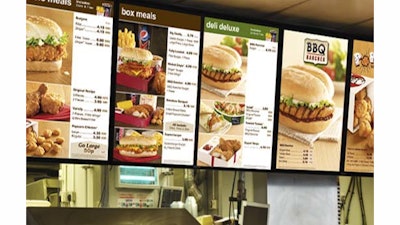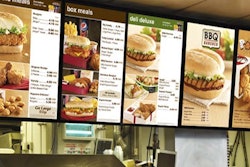
The Food and Drug Administration (FDA) has finalized its rules requiring that calorie information be listed on menus and menu boards of chains with at least 20 units operating under the same name and in connection with vending machines with at least 20 locations. The new rules are part of the federal government’s effort to fight obesity and will apply nationwide and preempt existing state laws covering the same types of foods and establishments, unless identical to the federal rules.
The new regulations were promulgated under the Patient Protection and Affordable Care Act of 2010, which requires restaurants and similar retail food establishments that are part of a chain with 20 or more locations doing business under the same name and offering for sale substantially the same menu items to provide calorie and other nutrition information for standard menu items, including food on display and self-service food. The new regulations are the result of an extensive review and commentary over several years, during which the FDA received over 1,100 comments.
Scott Pink and Barry Heller of DLA Piper LLP, a global law firm, have presented an overview of the new regulations. Following are key aspects of the new regulations.
1) Who is covered by the new requirements?
The menu labeling requirements apply to restaurants and similar retail food establishments that are part of a chain with 20 or more locations (a) doing business under the same name regardless of the type of ownership and (b) offering for sale substantially the same menu items. It applies to chain restaurants and restaurant franchise systems that operate under the same brand and offer substantially the same menu items. It applies to chains whether they operate under a particular brand or name or, if there is not a brand or name used (e.g., an establishment with the generic descriptor "concession stand"), then whether they operate under the name of the parent entity of the establishment.
To be covered, the retail food establishment must offer for sale “restaurant-type” food, which is food that is (i) usually eaten on the premises, while walking away, or soon after arriving at another location; and (ii) either: (A) served in restaurants or other establishments in which food is served for immediate human consumption or which is sold for sale or use in such establishments; or (B) processed and prepared primarily in a retail establishment, ready for human consumption and offered for sale to consumers but not for immediate human consumption in such establishment and which is not offered for sale outside such establishment.
Examples include bakeries, cafeterias, coffee shops, convenience stores, delicatessens, food service facilities located within entertainment venues (such as amusement parks, bowling alleys and movie theatres), food service vendors (e.g., ice cream shops and mall cookie counters), food takeout and/or delivery establishments (such as pizza takeout and delivery establishments), grocery stores, retail confectionery stores, superstores, quick service restaurants and table service restaurants.
The rules require that a restaurant have a fixed site, which means that it does not cover trains or airplanes and presumably food trucks if they are not fixed in any particular location. In addition, most K-12 schools are exempt from these requirements.
The covered establishments in the chain must also offer for sale substantially the same menu items, which means offering for sale a significant proportion of menu items that use the same general recipe and are prepared in substantially the same way with substantially the same food components, even if the name of the menu item varies from restaurant to restaurant.
2) What kind of food is covered by these new requirements?
The disclosure requirements apply to a “standard menu item," which is defined as a restaurant-type food that is routinely included on a menu or menu board or routinely offered as a self-service food or food on display. It covers food for immediate consumption, either eaten on the premises, while walking away or soon after arriving at another location.
Examples include food purchased at a sit-down or quick service restaurant or at a drive-through establishment; takeout and delivery pizza; hot pizza at grocery and convenience stores that is ready to eat; a pizza slice from a movie theater; hot buffet food and hot soup at a soup bar, and food from a salad bar; and foods ordered from a menu/menu board at a grocery store intended for individual consumption (e.g., soups, sandwiches and salads).
It also includes self-service foods and foods on display that are intended for individual consumption (and so long as there is not an ordinary expectation of future preparation before consumption), such as sandwiches, wraps and paninis at a deli counter; salads plated by the consumer at a salad bar; cookies from a mall cookie counter; and bagels, donuts and rolls offered for individual sale.
The following types of items are excluded from the labeling requirements:
- daily specials
- condiments
- temporary menu items that appear on a menu or menu board for less than a total of 60 days per calendar year. The 60 days includes the total of consecutive and nonconsecutive days the item appears on the menu
- custom orders, which is a food order that is prepared in a specific manner based on an individual customer’s request and which requires the covered establishment to deviate from its usual preparation of a standard menu item
- food that is part of a customary market test (food that appears on a menu or menu board for less than 90 consecutive days to test consumer acceptance) and
- self-service food and food on display that is offered for sale for less than a total of 60 days per calendar year or fewer than 90 consecutive days in order to test consumer acceptance.
Examples of excluded foods include foods to be eaten over several eating occasions or stored for later use (e.g., loaves of bread, bags or boxes of dinner rolls, whole cakes, bags or boxes of candy or cookies), foods that are usually further prepared before consuming (e.g., deli meats and cheeses) and foods sold by weight that are not self-serve and are not intended solely for individual consumption (e.g., deli salads sold by unit of weight, such as potato salad or chicken salad), either pre-packed or packed upon consumer request.
3) Is alcohol covered by the new federal menu labeling regulations?
Yes. The menu labeling requirements apply to alcoholic beverages served as standard menu items. Alcoholic beverages that are on display and are not self-service items (e.g., bottles of liquor behind the bar used to prepare mixed drinks) are exempt from the labeling requirements.
4) What information do I need to disclose and where do I disclose it?
The new regulations impose several new disclosure requirements.
- Calorie information: Covered establishments must provide calorie information for all standard menu items listed on the menu or menu board, as usually prepared and offered for sale. The number of calories must be specified to the nearest 5-calorie increments up to and including 50 calories, and to the nearest 10-calorie increment above 50 calories, except that amounts less than 5 calories may be expressed as zero. The calorie information must be placed adjacent to the name or the price of the associated standard menu item, in a type size no smaller than the name or price of the associated menu item, whichever is smaller, and with the same color or a color as conspicuous as the color or the price and item name and against the same or similar contrasting background. The heading “Calories" or "Cal" also must be included. Calories for standard menu items that are self-service or on display must be declared on signs adjacent to such foods and must disclose the serving size or discrete unit used to determine the calories (e.g. scoop, cup).
- Self-service or display Items: If the standard menu item is self-service or on display, then you must declare the calories per displayed food item (e.g., bagel, slice of pizza) or, if not sold in a discrete unit, then per serving or other discrete unit (e.g., “per scoop,” “per muffin”).
- Multiple serving items: The rule also explains how to disclose calorie information when an item, such as a pizza, has multiple servings. You can either declare the calories for the whole menu item listed on the menu or menu board as usually prepared and offered for sale (e.g., “pizza pie: 1,600 cal”), or per discrete serving unit, as long as the discrete serving unit (e.g., pizza slice) and total number of discrete serving units contained in the menu item are declared on the menu or menu board and the menu item is usually prepared and offered for sale divided in those same discrete serving units (e.g., “pizza pie: 200 cal/slice, 8 slices”).
- Beverages: If the beverage is provided on a self-service basis (such as from a soda fountain), then the calories must be calculated based on the number of fluid ounces in the cup in which the beverage is served and, if applicable, the description of the cup size. For example, a proper declaration might be “140 calorie per 12 fluid ounces (small).” If the beverage is not self-service (e.g., served by a waiter), the calories are to be based on the full serving size without ice, unless the covered establishment ordinarily dispenses and offers for sale a standard beverage fill (i.e., a fixed amount that is less than the full volume of the cup per cup size) or dispenses a standard ice fill (i.e., a fixed amount of ice per cup size). If the covered establishment ordinarily dispenses and offers for sale a standard beverage fill or dispenses a standard ice fill, the covered establishment must declare calories based on such standard beverage fill or standard ice fill.
- Variable menu items: The rule also covers standard menu items that come in different sizes, flavors, varieties or combinations and are listed as a single menu item. As a general rule, you must provide the calorie information for each listed size, flavor or variety. The rule also describes how to handle other types of variable items, such as when the individual variable items are not listed or only partially listed or when a food item includes toppings.
- Nutrition statement: Each menu and menu board must contain the following succinct statement regarding daily calorie intake: “2,000 calories a day is used for general nutrition advice, but calorie needs vary." For menus and menu boards targeted to children, the following options may be used as a substitute for or in addition to the succinct statement: "1,200 to 1,400 calories a day is used for general nutrition advice for children ages 4 to 8 years, but calorie needs vary"; or "1,200 to 1,400 calories a day is used for general nutrition advice for children ages 4 to 8 years and 1,400 to 2,000 calories a day for children ages 9 to 13 years, but calorie needs vary." This statement must appear at the bottom of each menu page and on the bottom of the menu board. There are requirements regarding font size, color and contrast background similar to those for calorie disclosures.
- Nutritional information: Covered establishments are also required to provide the following nutritional information for standard menu items to consumers on request, in the following order and using the following measurements: (a) Total calories (cal); (b) Calories from fat (fat cal); (c) Total fat (g); (d) Saturated fat (g); (e) Trans fat (g); (f) Cholesterol (mg); (g) Sodium (mg); (h) Total carbohydrate (g); (i) Dietary fiber (g); (j) Sugars (g); and (k) Protein (g). If you have insignificant amounts of 6 or more of these nutrients, you can use a simplified format. This written information can be presented in a variety of ways, including in a counter card, sign, poster, handout, booklet, loose leaf binder or electronic device such as a computer, or in a menu.
- Statement of availability of nutritional information: Each menu and menu board must also contain the following statement regarding the availability of the written nutrition information: “Additional nutrition information available upon request." This statement is subject to requirements regarding location, font size, color and contrasting background similar to those for the nutritional statement.
5) Do I have to substantiate the calorie and nutritional information I declare?
Yes. The new rule requires that you have a reasonable basis for the nutrient declarations. There are a variety of information sources that can be used for such substantiation, including nutrient databases (with or without computer software programs), cookbooks, laboratory analyses, or Nutrition Facts labels on packaged foods that comply with federal nutrition labeling requirements or the nutrient values for raw fruits, vegetables or cooked fish established by the FDA. You need to keep records of your substantiation and make them available to the FDA within a reasonable period of time upon request along with certain required certifications.
6) Can I comply with the new federal rule even if I am not a covered establishment?
Yes, there is a voluntary registration procedure established under which restaurants and similar retail food establishments not otherwise subject to the rule could elect to be subject to the requirements by registering with FDA. A benefit for such registrants is that they would not be subject to conflicting state laws.
7) Do I still have to comply with state and local menu labeling regulations?
The FDA states that they interpret the federal law to preempt state and local government nutrition labeling requirements for food sold in a covered establishment or establishment that voluntarily registers with the FDA, unless such laws are identical to the federal requirements. States can still impose requirements for establishments that are not covered by the new federal rule (provided they have not voluntarily registered with the FDA). However, the debate over the scope of this preemption is likely to continue.
8) What is the deadline for compliance?
Dec. 1, 2015.
9) What if I don’t comply by that date?
Any covered foods that are sold by a covered establishment without proper calorie or nutritional declarations or disclosures are considered misbranded under the Food, Drug and Cosmetic Act. This can result in the FDA sending warning letters or bringing enforcement actions to seek injunctive relief, penalties and other relief.
10) What are the vending machine requirements?
Any owner or operator of 20 or more vending machines is required to declare calorie information for any food sold in the vending machines. Calorie declarations must be clear and conspicuous and placed prominently and may be placed on a sign in, on or adjacent to the vending machine, so long as the sign is in close proximity to the article of food or selection button. The final rule establishes type size, color and contrast requirements for calorie declarations in or on the vending machines and for calorie declarations on signs adjacent to the vending machines, including disclosures on electronic vending machines.
Declarations are not required if a prospective purchaser can view certain calorie information on the front of the package, in the Nutrition Facts label on the food or in a reproduction of the Nutrition Facts label on the food.
The final rule also requires contact information for the vending machine operator to be displayed for enforcement purposes. Covered vending machine owners and operators have until Dec. 1, 2016 to comply with these new requirements.


















